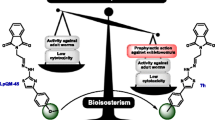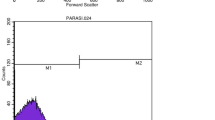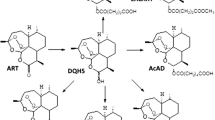Abstract
Parasite-specific putrescine-N-acetyltransferase and polyamine oxidase, both involved in the reversed pathway of polyamine metabolism, were demonstrated for Ascaris suum and Onchocerca volvulus. Berenil-treatment was found to be correlated with accumulation of polyamines, especially spermine, obviously due to blockaded polyamine interconversion. Furthermore it was shown that added spermine to the culture medium led to the death of worms. These specificities might be exploited for chemotherapy of filarial infections.
Polyamines are widely distributed in the nature. They are found in higher and lower eucaryotes and in procaryotes as well as in viruses (Tabor and Tabor, 1984). During the last years there have been many approaches to examine the role of polyamines in cell growth and differentiation in vertebrates (Tabor and Tabor, 1984; Pegg, 1986). The polyamine metabolism of parasites also has attracted increasing interest, e. g. in African trypanosomes the initial enzyme of polyamine synthesis — ornithine decarboxylase — has been exploited as a target for chemotherapy by using DFMO (DLα-difluoro-methylornithine) (Bacchi et al., 1980; Bacchi et al., 1983; Fairlamb et al., 1985; Giffin et al., 1986).
The polyamine metabolism of filaria and other helminths is still a neglected area of research, although there are reports about distribution pattern of polyamines and some peculiarities of polyamine metabolism in filarial worms (Srivastava et al., 1980; Wittich et al., 1987; Walter, 1988). DFMO and MGBG (methylglyoxal bis-(guanylhydrazone)), both of which are potent inhibitors of polyamine synthesis in mammals, do not significantly effect the viability of filarial worms (Wittich et al., 1987). If synthesis via ornithine as well as arginine decarboxylase could finally be denied, the absolute dependence of filarial worms on their host for a supply with polyamines would offer some leads for chemotherapy of river blindness and lymphatic fila-riasis. It should be demonstrated for filaria and other helminths that blockade and disturbance of polyamine synthesis and distribution leads to death of worms. Furthermore the enzymes involved in the interconversion pathway should be identified and their potential as targets for design and developement of enzyme inhibitors to antifilarial drugs should be studied.
Access this chapter
Tax calculation will be finalised at checkout
Purchases are for personal use only
Preview
Unable to display preview. Download preview PDF.
Similar content being viewed by others
References
Bacchi, C. J., Nathan, H. C., Hunter, S. H., 1980, Polyamine metabolism: A potential therapeutic target in trypanosomes, Science, 210: 332–334.
Bacchi, C. J., Garofalo, J., Mockenhaupt, D., McCann, P. P., Diekema, K. A., Pegg, A. E., Nathan, H. C., Mullany, E. A., Chunosoff, L., Sjoerdsma, A., Hunter, S. H., 1983, In vivo effects of-D, L-difluoromethyl-ornithine on the metabolism and morphology of trypanosoma brucei brucei, Mol. Biochem., Parasitol., 7: 209–225.
Balana-Fouce, R., Garzon-Pulido, T., Ordonez-Escudero, D., and Garrido-Pertierra, A., 1986, Inhibition of diamine oxidase and S-adenosyl-methionine decarboxylase by diminaceneaceturate (berenil), Biochem.Pharmacol., 35(9): 1597–1600.
Bey, P., Bolkenius, F. N., Seiler, N., and Casara, P., 1985, N-2, 3-butadienyl-1, 4-butanediamine derivatives: Potent irreversible inactivators of mammalian polyamine oxidase, J. Med. Chem., 28(l): 1–2.
Bitonti, A. J., Dumont, J. A., and McCann, P. P., 1986, Characterisation of trypanosoma brucei brucei S-adenosyl-L-metnionine decarboxylase and its inhibition by berenil, pentamidine and methylglyoxal bis(guanyl-hydrazone), Biochem. J., 237: 685–689.
Bolkenius, F. N., and Seiler, N., 1987, The role of polyamine reutilization in depletion of cellular stores of polyamines in non-proliferating tissues, Biochem. Biophys. Acta, 923: 125–135.
Fairlamb, A. H., Blackburn, P., Ulrich, P., Chait, B. F., and Cerami, A., 1985, Trypanothione. A novel bis(glutathionyl)spermidine cofactor for glutathione reductase in trypanosomatids, Science, 227: 1485–1487.
Ferrante, A., Ljungstrom, I., Rzepzyk, C. M., and Morgan, D. M. L., 1986, Differences in sensitivity of Schistosoma mansoni schistosomula, Dirofilaria immitis microfilariae and Nematospiroides dubius third-stage larvae to damage by polyamine oxidase-polyamine system, Infect.Immun., 53(3): 606–610.
Franke, E. D., and Weinstein, P. P., 1983, Dipetalonema vitae (Nematoda: Filarioidea): Culture of third-stage larvae to young adults in vitro, Science, 221: 161–163.
Giffin, B. F., McCann, P. P., Bitonti, A. J., and Bacchi, C. J., 1986, Polyamine depletion following exposure to DL-difluoromethylornithine both in vivo and in vitro initiates morphological alterations and mitochondrial activation in a monomorphic strain of trypanosoma brucei brucei, J. Protozool., 33(2): 238–243.
Karvonen, E., Kauppinen, L., Partanen, T., and Pösö, H., 1985, Irreversible inhibition of putrescine-stimulated S-adenosyl-L-methionine decarboxylase by berenil and pentamidine, Biochem. J., 231: 165–169.
Libby, P. R., 1978, Calf liver nuclear N-acetyltransferase, J. Biol. Chem., 253: 233–237.
Libby, P. R., 1980, Rat liver nuclear N-acetyltransferase: Seperation of two enzymes with both histone and spermidine acetyltransferase activity, Arch. Biochem. Biophys., 203: 384–389.
McCann, P. P., Bacchi, C. J., Nathan, H. C, and Sjoerdsma, A., 1983, in “Mechanism of Drug Action”, T. P. Singer and R. N. Ordarza, eds., Academic Press, New York.
Morgan, D. M. L., Bachrach, U., Assaraf, Y. G., Harari, E., and Golenser, J., 1986, The effect of purified aminoaldehydes produced by polyamine oxidation on developement in vitro of Plasmodium falciparum in normal and glucose-6-phosphate-dehydrogenase-deficient erythrocytes, Biochem. J., 236: 97–101.
Müller, S., and Walter, R. D., 1988, Effect of berenil and spermine on viability and polyamine metabolism of filarial worms in vitro, International Symposium on Polyamines in Biochemistry and Clinical research, Sorrento, Naples, Italy, 13-17 June 1988 (Abstract).
Müller, S., Wittich, R.-M., and Walter, R. D., Characteristics and function of polyamine oxidase in nematodes, Zbl. Bakt. Hyg., in press.
Pegg, A. E., 1986, Recent advances in the biochemistry of polyamines in eukaryotes, Biochem. J., 234: 249–262.
Rathauer, S., Wittich, R.-M., and Walter, R. D., 1988, Ascaris suum and Onchocerca volvulus: S-adenosylmethionine decarboxylase, Exp. Parasitol., 65: 277–281.
Seiler, N., and Al-Therib, M. J., 1974, Putrescine catabolism in mammalian brain, Biochem. J., 144: 29–35.
Srivastava, D. K., Roy, T. K., and Shukla, O. P., 1980, Polyamines of helminths, Ind. J. Parasitol., 4(2): 187–189.
Tabor, C. W., and Tabor, H., 1984, Polyamines, Annu. Rev. Biochem., 53: 749–790.
Walter R. D., 1988, Polyamine metabolism in filaria and allied parasites, Parasitol. Today, 4(4): 18–20.
Williams-Ashman, H. G., and Seidenfeld, J., 1986, Aspects of the biochemical pharmacology of methylglyoxal bis(guanylhydrazone), Biochem. Pharmacol., 35(8): 1217–1225.
Wittich, R.-M., Kilian, H.-D., and Walter, R. D., 1987, Polyamine metabolism in filarial worms, Mol. Biochem. Parasitol., 24: 155–162.
Wittich, R.-M., and Walter, R. D., 1988, A novel putrescine (diamine) N-acetyltransferase from Onchocerca volvulus and Ascaris suum, International Symposium on Polyamines in Biochemistry and Clinical Research, Sorrento, Naples, Italy, 13-17 June 1988 (Abstract).
Author information
Authors and Affiliations
Editor information
Editors and Affiliations
Rights and permissions
Copyright information
© 1988 Plenum Press, New York
About this chapter
Cite this chapter
Müller, S., Wittich, RM., Walter, R.D. (1988). The Polyamine Metabolism of Filarial Worms as Chemotherapeutic Target. In: Zappia, V., Pegg, A.E. (eds) Progress in Polyamine Research. Advances in Experimental Medicine and Biology, vol 250. Springer, Boston, MA. https://doi.org/10.1007/978-1-4684-5637-0_65
Download citation
DOI: https://doi.org/10.1007/978-1-4684-5637-0_65
Publisher Name: Springer, Boston, MA
Print ISBN: 978-1-4684-5639-4
Online ISBN: 978-1-4684-5637-0
eBook Packages: Springer Book Archive




